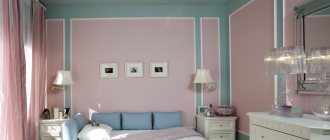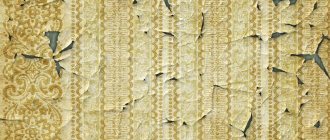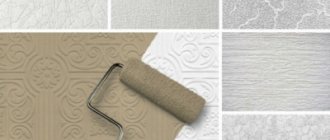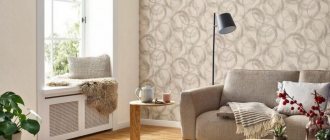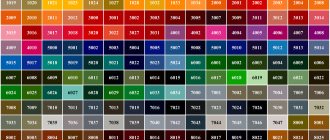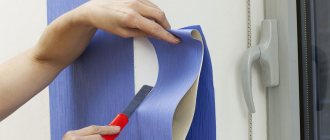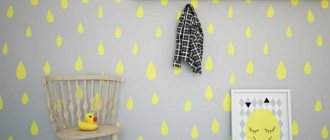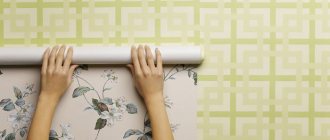0
05.01.2022
In order to change the interior of a room, they often use such a budget approach as painting wallpaper. Many have heard about this, but do not understand the essence. Before painting the walls, the owner needs to understand that not all types of wallpaper are suitable for this method of transformation. And only if certain fabrics were initially used for finishing, will it be possible to change their color. How to steal wallpaper is described in some detail below.
Painted walls can decorate any room
Paintable wallpaper: pros and cons
Page navigation
When choosing a method of decorating a room such as painting wallpaper, you need to study all the advantages and disadvantages of the chosen method.
| pros | Minuses |
| You can change the shade depending on personal preferences. | If the paint layer is too large, the color distribution may be uneven. |
| The shade can be selected individually, in a very wide range. | Not all types of wallpaper can be painted. |
| There is no need to carry out complex preparatory work. | For high-quality coloring, you must use the services of a specialist. |
| Errors and stains often give the room an unusual texture and stylish design. | |
| This method of decorating a room is inexpensive. | |
| The paint is safe for humans and rarely causes allergic reactions. |
Painting wallpaper is often chosen as a budget-friendly and simple method of decorating a room.
However, it must be taken into account that incorrect application of paint can lead to the room looking unkempt. It is very important to know whether it is possible to paint the wallpaper that covers the walls.
The shade of the walls can be changed frequently without spending a lot of money
Can all types of wallpaper be painted?
This is only possible if the stands are covered with non-woven wallpaper, paper wallpaper, or with a fiberglass base. Currently, non-woven wallpaper is most often used. We will reveal the advantages of this wallpaper and give instructions on how to paint it yourself, pointing out the advantages and disadvantages.
Positive aspects of painting wallpaper:
- helps hide uneven walls;
- become durable and moisture resistant;
- not subject to mechanical stress.
The only drawback of this process is its high cost.
What you need to know before starting work
To figure out how to paint wallpaper, you first need to understand the technology of finishing with the appropriate wallpaper. The following features of the procedure must be taken into account:
- so that the canvases that are being painted do not fall off the walls, you need to use a special adhesive with increased fixation;
- In order for the pattern to be uniform, the paint must be liquid (too thick a substance leads to the fact that the color does not apply evenly);
- when painting paper materials, it is necessary to use a thin application so that the wall covering does not have time to get wet;
- You can add texture using rollers with long pile.
If old wallpaper with defects is painted, it is necessary to use a thick layer of paint, which hides the defects and makes the walls evenly painted.
How to paint wallpaper correctly
To properly paint the wallpaper you will need:
- roller (one or more different sizes);
- tray (preferably with a squeezing mesh);
- container for diluting dye;
- small brush for corners and areas along baseboards;
- masking tape;
- cloth or sponge to remove accidental drops;
- film for protecting floors and furniture;
- stepladder, chair or telescopic handle for a roller.
Tools needed for painting wallpaper
Before painting, the surface must be checked for defects. Glue the peeled corners of the canvases, pierce the air bubbles with a needle. If it was necessary to use glue to eliminate errors, painting should not begin earlier than in a day. Only dry surfaces can be painted.
The next step is to clean the wallpaper from dust and dirt. To do this, use a broom, a dry rag, or better yet, a vacuum cleaner at low power. Then the canvases are degreased by wiping with a sponge soaked in soapy water.
Wait until the surface is dry and begin painting. Before painting, non-woven and glass wallpapers are primed. The primer mixture (primer) is applied with a roller or brush in 1-2 layers. You can apply the paint after the primer has completely dried.
The color mixture is diluted and tinted immediately before application. It is better to pour a small amount into the tray and close the container with the working material to prevent it from drying out. Any paint is diluted in accordance with the manufacturer's instructions - the consistency should be similar to liquid sour cream. Before starting work, it is useful to roll velor and fur rollers with masking tape so that they do not leave lint during painting. The optimal temperature in the room for painting work is 17-25 degrees, the windows are closed.
Having completed the preparatory work, begin painting:
- use a small roller or brush to paint strips up to 10 cm wide along the baseboards;
- paint the relief elements with a brush;
- Using a roller well soaked in dye, paint the main part of the surface from top to bottom. Do not keep the roller in one place for a long time;
- If blisters appear on the wallpaper during the painting process, pierce them with a needle and glue these parts of the canvas to the wall.
The second coat of paint may be applied only after the first has completely dried.
If you want to apply a design to the wallpaper, use a textured roller, stencil or stamp.
Textured roller
How long after pasting can wallpaper be painted?
To ensure that the paint adheres well and does not cause stains, it is necessary to use only a properly prepared surface.
After gluing, the canvases must dry thoroughly. After that, the quality of gluing the joints is checked and only then paint is applied.
In order for the wallpaper to dry quickly, it is necessary to create good conditions in the apartment. The room should be warm and free from draft.
Not all wallpaper can be painted
Types of wallpaper that can be painted
To get a smooth surface, you need to understand what kind of wallpaper can be painted. These paintings include:
- Non-woven. Such fabrics are most often used for dyeing. Regardless of the number of layers, the surface is smooth and attractive. Also among the positive properties is the fact that non-woven materials hide the imperfections of the walls.
- Glass wallpaper. Despite the high cost, such canvases are often used. You can repaint the walls any color, but it is recommended to use a coat of primer before painting.
- Liquid. This type of material can be painted with acrylic paints. The coating is durable and is often used in high traffic areas.
- Linkrusta. Designed for coloring and creating unusual designs. Linkrusts can be painted with your own hands without the help of specialists.
In order for the color to apply evenly on the wall, you need to ensure that there are no defects on the surface. Experts do not recommend painting paper-based vinyl materials.
Paper materials are also dyed. However, before the procedure, a special impregnation should be used, which increases the strength of the material.
With correctly selected canvases, the color applies evenly
What wallpaper can be painted
Before painting the walls, it is important to find out what type of wallpaper is applied to them. Or choose the right coating when you are only planning to carry out cosmetic repairs.
Most often, canvases for painting are produced in white colors - they will become an excellent basis for applying color designs.
The following types of coatings can be found on store shelves:
- Paper for painting. This material is impregnated with a special moisture-repellent impregnation. Conventional paper rolls with one layer are not suitable for this task. Canvases for painting are made from several materials - first there is a substrate, then a layer reinforced with sawdust, then the front part. Paper canvas can be repainted no more than 3 times. The paint is applied in a thin layer; if there are unpainted plots, then you need to apply another layer.
- From fiberglass. This coating seems to be very durable, because it is assembled from glass threads. Therefore, glass wallpaper is not subject to abrasion, mechanical damage, moisture and fire. The material perfectly covers unevenness and blemishes on the walls. Easily cleans when dirt gets in and washes off. You can paint it with different paints, but before doing this you need to apply primer to the wallpaper. Among the advantages is that they can be repainted up to 8 times.
- On a non-woven basis. This coating has good density and heavy weight, making it suitable for painting. Made from 2 layers: cellulose and polymer. Due to the composition and thickening, they are not afraid of moisture and perfectly cover gaps in the surface. Can withstand repainting up to 8 times. In this case, the texture on the canvas will lose its former expression.
- Vinyl types. The coating consists of 2 layers: the top one is a polymer, and the bottom one is a base made of non-woven fabric or paper. For painting, it is worth choosing washable wallpaper samples. They are coated with a moisture-resistant compound that can withstand staining. Can be painted several times.
- Liquid is an unusual type of decorative plaster. It can be painted, although manufacturers claim that this will not work. However, because of this, such characteristics as patterns and silky relief will not appear.
What to paint: choosing “wallpaper” paint
For a smooth surface, it is important to choose high-quality paint. Among the most common types it is necessary to highlight:
- alkyd;
- acrylic;
- water-based.
For residential premises it is recommended to use water-based and acrylic paints. The advantage of the first type is its affordable cost and easy application. However, acrylic ones have a longer service life and brighter shades.
Despite the fact that alkyd colors have a long service life and protect the surface from mold, they contain substances harmful to the human body. Therefore, this type of coating is not used in apartments.
Types of wallpaper for painting and options for choosing paint
There are three types of coatings, and each requires its own coloring materials. For convenience, we have compiled a summary table. It presents the pros and cons of each type of wallpaper and options for the corresponding paints.
| Characteristics | Type of wallpaper | ||
| Paper | Non-woven | Fiberglass | |
| Advantages | Inexpensive. Easy to glue. | They don't wrinkle. Resistant to stretching and tearing. Hide minor wall irregularities. They allow air to pass through well, which prevents the formation of mold. You can find anti-vandal options with increased strength. | Wear-, fire- and heat-resistant. Durable. Repels dust and moisture. They mask surface imperfections well. They have high sound absorption. |
| Flaws | They do not hide defects well, so it is recommended to glue them to smooth walls. They have little abrasion resistance. Easily torn. | Relatively high price. | The most expensive option. A primer is needed before painting. |
| Number of paintings | Up to 5 | 8-10 | 10-11 |
| Suitable paint type | Water-based. | Water-emulsion or water-dispersion. | Latex or acrylic. |
The above division of the correspondence between paints and types of wallpaper is conditional: the non-woven base can also be painted with a latex mixture if the room has high humidity and it is necessary to protect the coating from moisture, for example, in the kitchen. But if you do not have any special conditions, follow our recommendations when choosing finishing materials.
Color options
There can be a large number of options for painting walls. It is necessary to highlight the most common ones:
- Monochromatic coloring. This type involves covering the wall in one color without embossed decorations.
- Relief painting. For such purposes, special wallpaper is purchased that has a relief pattern.
- Painting in several colors. Thus, you can create an unusual interior at home. You can do it yourself, without large financial expenses, but you need to correctly combine colors.
Using textured wallpaper you can get a seamless surface. Since small drawings visually smooth out the wall and hide defects.
The combination of several shades allows you to create an unusual interior
Design options
Before painting a room, you should think about the overall color scheme and design. Depending on the idea and the overall tone of the interior, you can paint a wall in different ways.
- Single color paint. The most common, simple and fast option, suitable for discreet and austere interiors.
- Painting in several tones. Here you can already show your imagination. You can paint each wall a separate color; sometimes it is necessary to highlight a niche with color, create a frame under the head of a bed or a false fireplace, etc. Colors can be alternated on one wall, creating stripes, diamonds, or applying paint in several layers using stencils.
- Uneven paint application. This method is especially appreciated in grunge or loft style interiors. The paint is applied with sharp strokes, sometimes diluted with a solvent to create an uneven texture and smudges.
- Craquelure effect. Created with a special varnish. Applied on top of the main background, it causes the paint to crack openly. Adds a slight antique effect, emphasizing the sophistication of the room.
- Gradient. If you paint the wall with two different shades, and then, even before the paint dries, start mixing it carefully (at the junction of colors) with a dry roller, you can get a very smooth, beautiful transition.
Do-it-yourself drawing on wallpaper
To make the interior of the room unusual, you can create a picture on the wall. The procedure can be carried out using several methods:
- Using stencils. The simplest and most accessible method for everyone. Using stencils, unusual patterns are created on the surface.
- Use a thick bristled roller. This method can give the wall relief. You can also purchase special rollers that already have an ornament on them.
- With a brush. Suitable for those who can draw.
Often for small rooms, chaotic application of paint of different shades is used. This way you can get a unique combination of colors, while visually enlarging the room.
Drawings can be created using stencils
Some useful tips
- After painting, the wallpaper can be covered with a layer of acrylic varnish. It will fix the paint layer, protect it from moisture and allow you to wash the wallpaper.
- Paper wallpapers are designed for 5 repaintings, non-woven and fiberglass wallpapers can withstand up to 10.
- Wallpaper overloaded with paint will lag behind the walls.
- The more layers of paint, the less noticeable the relief pattern.
- Latex and acrylic painting allows you to wash wallpaper without fear of damaging it. These paints create a waterproof film.
Paintable wallpaper provides ample opportunities for decorating interiors in different styles. By showing your imagination and putting your hands to work, you can give your living space individuality and originality. Imagine, create and bring your ideas to life.
- Author: Irina Vasilyeva
Hello! My name is Irina, I am 48 years old. Rate this article:
- 5
- 4
- 3
- 2
- 1
(23 votes, average: 4.1 out of 5)
Share with your friends!
Preparation before painting
Before starting the process at home, the room must be properly prepared.
The following features are taken into account:
- All furniture must be removed from the room;
- objects that are too heavy are covered with film;
- wallpaper is wiped with a dry cloth;
- prepare paint, which should resemble liquid sour cream in consistency;
- close all windows and maintain the temperature at least 20 degrees.
When preparing paint, you need to mix the volume for the entire room. Since it is almost impossible to get a perfectly similar shade again.
Painting and finishing of the canvas
After applying and drying the primer layer, proceed directly to painting the canvas. To do this, pour a third of the paint can into a bucket and add solvent. Mix the ingredients thoroughly and pour the mixture into the cuvette. Wet the roller and start painting. It is best to apply paint to the walls starting from the top and gradually moving down.
Be sure to ensure that after application there are no drips or unpainted areas.
The paint is mixed with solvent in a ditch.
As soon as the first layer is completely dry, begin applying the second layer. After painting large areas, begin applying the compound in hard-to-reach areas. To do this, lower the brush into the paint tray and start painting in the upper corner of the room. When painting, make sure that no lint remains on the wall after brushing.
After the second layer has completely dried, you can begin to decorate the canvas with a decorative layer. Before doing this, we advise you to make a rough drawing of your patterns and follow it. Try to put maximum imagination and creativity into your image to make the interior of your room original.
After the third layer has dried, you can also coat the finish with clear varnish. This will be especially relevant when decorating children's rooms, where it is unlikely that mechanical damage to the finish will be avoided.
Wallpaper coloring technology
To understand how to paint paintable wallpaper yourself, you should follow the step-by-step guide:
- Rinse the roller thoroughly with warm water. A procedure is carried out to remove small particles of lint.
- The color must be applied from the ceiling. For the ceiling part, lighter shades are chosen than for the walls. The paint is applied with a small roller. The joints are painted with brushes.
- The walls are painted from top to bottom. Places with relief details must be painted several times.
- The baseboards are sealed with masking tape. The joints between the floor and the wall are treated with a small brush.
In order for the chosen shade to lie beautifully on the surface, it is necessary to stir the paint regularly. By following simple tips, even a novice master can create an unusual interior.
Following the correct technology allows you to create a perfectly flat surface
How to paint wallpaper: step-by-step instructions
Now let's move on to the painting work. They can be started 3 days after gluing, when the glue is completely dry. If there is furniture in the room, cover it with protective film, polyethylene can also be used to cover the floor, or use newspapers. Cover skirting boards, sockets, switches, pipes, etc. with masking tape.
For painting you will need a standard set of tools for painting:
- Roller. Choose it depending on the texture of the wallpaper: the larger and more pronounced it is, the longer the pile should be. For example, for the MARBURG Lazer model, the COLOR EXPERT sample with a pile of 12 mm is suitable. A velor short-hair roller will paint only the design without affecting the base.
- Cuvette or bath for dispensing paint.
- Brush for painting in hard-to-reach places.
Wear old clothing, glasses, gloves and a hat to protect your skin, eyes and hair. Water-based emulsion washes off well with water, but to remove latex paints, special solutions are needed that can cause irritation to the epidermis.
The procedure for painting wallpaper
When you have everything prepared, you can start painting. Let us describe in detail the sequence of actions:
- Pour paint into the recess of the cuvette so that it fills it, but does not cover the relief surface.
- Dip the brush, remove excess, and work it along the ceiling and in hard-to-reach areas.
- Dip the roller into the paint and roll over the surface several times to remove excess. If there is too much paint, there will be smudges and you will splatter everything around.
- Start working from top to bottom. Paint the areas evenly, move consistently in one direction, for example, only vertically.
- The paint is always applied in 2 layers, so do not try to carefully paint every relief depression. Your task is to apply a layer without visible gaps.
To ensure the paint lays evenly, do not interrupt your work. Experts recommend turning off your phone and not being distracted until the process is completed.
- When you have painted the walls once, you need to let the coating dry. The drying time is indicated in the instructions for the paint, but it usually takes at least an hour. To prevent the roller from drying out, wrap it in plastic.
- Start painting the wallpaper the second time, following the same sequence as the first time.
Remove splashes and drips while the paint is fresh. Be sure to wash and dry the tools after finishing work.
How to repaint wallpaper for painting
You can change the color of the coating at any time, provided that the previous layer has dried. If you are repainting light shades into dark ones, proceed as described above. To change a dark color to a lighter one, use a trick: first cover the wallpaper with a layer of white paint, and then move on to colored paint. Otherwise, in order to completely eliminate the dark shade, you will have to apply 3-5 layers of light.
Keep in mind: the more layers of paint, the less noticeable the relief. If you have wallpaper with a subtle texture, after 4-5 stains it will seem smooth.
How to repaint canvases
If the painted walls are not satisfied with the final result, they can be repainted. To do this, you should wait until the canvas is completely dry and only then begin the process.
Features of repainting dark wallpaper in a light tone
Dark shades visually make the room cramped and small, so painting is often done using a lighter color.
To prevent dark spots from appearing on the surface in the future, it is necessary to apply white paint very carefully. After the surface is completely dry, apply the selected color.
Canvases with a relief pattern must be lightened several times. After the surface turns white, apply the selected shade.
To paint dark canvases, they must first be lightened.
How to correctly calculate the required amount of paint?
To ensure you have enough paint, you must calculate the required amount of composition. To do this, take into account factors such as the total area of the pasted surface, the consumption of the coloring composition per 1 m2 and the absorbent properties of the canvas.
The paint can usually indicates the approximate consumption per square meter
The total area includes the area of all walls and ceiling, if you plan to paint that too. From these indicators, subtract the area of the windows and add approximately 200–300 g of paint in reserve. As a result, you will get the total working surface area.
The approximate paint consumption per square meter is indicated by the manufacturer on the can with the composition. Please note that each manufacturer’s paint differs in absorption properties and density, so it will be used differently. The “standard” consumption is about 200 g/m2. If the paint is applied in 2 layers, then this figure will increase to 250 g/m2. It is also important to take into account the ability of the canvas to absorb paint. Thus, wallpaper made of paper and non-woven material absorbs much more composition than fiberglass materials.
Secrets of proper painting - what experts recommend
To ensure that the result is pleasing for a long time, experts recommend taking into account the following tips when painting:
- Do not apply paint to canvases that are not intended for such purposes. If this advice is not followed, the painted result will begin to deteriorate over time and stains will appear on the surface.
- Paint a wall in one day. Many novice builders divide the color application process over several days. The paint may thicken, causing the color to change.
- Using one layer. To save money, only one layer is applied to the walls. Such actions are incorrect and will lead to the appearance of dark spots over time.
There are a large number of ideas for painting canvases. In order to make a room interesting and stylish, you don’t need to be afraid to experiment. Often, a combination of several colors allows you to get a cozy interior without the help of specialists.
Types of wallpaper paint by texture
Depending on the quality of the finishing coating, there are 4 types of paint:
- Glossy has a high reflective ability, visually expands the room and makes it brighter. With its help, you can create the effect of a mirror surface on the walls, but all their irregularities will become noticeable.
- Matte smoothes out imperfections and dims light. It is used to make a room more comfortable.
- Semi-matte is a compromise between matte and glossy. It has vaguely expressed properties of each.
- Satin is characterized by increased wear resistance and moderate shine, like silk.
You can buy a ready-made shade, tint it yourself or in a store. This service is available in all construction hypermarkets. In case of tinting yourself, immediately prepare the entire volume of paint for the entire area. If there is not enough of it, you will not be able to remix the tone-on-tone mixture.
